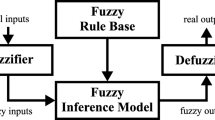Abstract
Researchers and engineers may use inferential logic and/or fuzzy logic to solve real-world causal problems. Inferential logic uses probability theories, while fuzzy logic uses its membership functions and set theories to process uncertainty and fuzziness of the events. To benefit from both logics, some researchers in the past tried to create probabilistic fuzzy logic (PFL). Deep Learning algorithms (DLs) with their incredible achievements such as very high precision results in some specific tasks are at the center of the weak AI. However, DLs fail when it comes to causal reasoning. In order to equip Deep Learning algorithms (DLs) with reasoning capabilities, one solution would be to integrate non-classical logics such as PFL with DLs. In this paper, we will demonstrate the first step toward creating a deep causal probabilistic fuzzy logic architecture capable of reasoning with missing or noisy datasets. To do so, the architecture uses fuzzy theories, probabilistic theories, and deep learning algorithms such as causal effect variational autoencoders.
Access this chapter
Tax calculation will be finalised at checkout
Purchases are for personal use only
Similar content being viewed by others
Notes
- 1.
- 2.
- 3.
If the true parameters of a statistical model can be learned after observing sufficient number of observations, the model is said to be identifiable. Wikipedia.
- 4.
- 5.
- 6.
References
Bezdek, J.C., Ehrlich, R., Full, W.: FCM: The fuzzy c-means clustering algorithm. Comput. Geosci. 10(2–3), 191–203 (1984)
Louizos, C., Shalit, U., Mooij, J.M., Sontag, D., Zemel, R., Welling, M.: Causal effect inference with deep latent-variable models. In: Advances in Neural Information Processing Systems, p. 6446–6456 (2017)
Faghihi, U., Robert, S., Poirier, P., Barkaoui, Y.: From association to reasoning, an alternative to pearl’s causal reasoning. In: Proceedings of AAAI-FLAIRS 2020. North-Miami-Beach (Florida) (2020)
Faghihi, U., Maldonado-Bouchard, S., Biskri, I.: Science of data: from correlation to causation. Springer (2021)
An, J., Cho, S.: Variational autoencoder based anomaly detection using reconstruction probability. Spec. Lect. IE 2(1), 1–18 (2015)
Yao, L., Li, S., Li, Y., Huai, M., Gao, J., Zhang, A.: Representation learning for treatment effect estimation from observational data. Adv. Neural Inform. Process. Syst. 31 (2018)
Guo, R., Cheng, L., Li, J., Hahn, P.R., Liu, H.: A survey of learning causality with data: problems and methods. ACM Comput. Surv. (CSUR) 53(4), 1–37 (2020)
Roeder, G., Metz, L., Kingma, D.: On linear identifiability of learned representations. In: International Conference on Machine Learning. PMLR (2021)
Hill, J.L.: Bayesian nonparametric modeling for causal inference. J. Comput. Graph. Stat. 20(1), 217–240 (2011)
Chipman, H.A., George, E.I., McCulloch, R.E.: BART: Bayesian additive regression trees. Ann. Appl. Stat. 4(1), 266–298 (2010)
Shalit, U., Johansson, F.D., Sontag, D.: Estimating individual treatment effect: generalization bounds and algorithms. In: International Conference on Machine Learning. PMLR (2017)
Khemakhem, I., Kingma, D., Monti, R., Hyvarinen, A.: Variational autoencoders and nonlinear ica: A unifying framework. In: International Conference on Artificial Intelligence and Statistics, p. 2207–2217. PMLR (2020)
Wu, P., Fukumizu, K.: Intact-VAE: estimating treatment effects under unobserved confounding. arXiv preprint arXiv:2101.06662 (2021)
Yager, R.R., Zadeh, L.A.: An introduction to fuzzy logic applications in intelligent systems, vol. 165. Springer Science & Business Media (2012)
Zhao, D.-M., Wang, J.-H., Wu, J., Ma, J.-F.: Using fuzzy logic and entropy theory to risk assessment of the information security. In: 2005 International Conference on Machine Learning and Cybernetics. IEEE (2005)
Cheng, P.-C., Rohatgi, P., Keser, C., Karger, P.A., Wagner, G.M., Reninger, A.S.: Fuzzy multi-level security: An experiment on quantified risk-adaptive access control. In: 2007 IEEE Symposium on Security and Privacy (SP’07). IEEE (2007)
Saki, A., Faghihi, U.: Fuzzy Rule Based Probability Theory (IN PREPARATION) (2022)
Ng, A.: O’Reilly, and Associates, AI is the New Electricity. O’Reilly Media (2018)
Sharma, A., Kiciman, E.: DoWhy: An end-to-end library for causal inference. arXiv preprint arXiv:2011.04216 (2020)
Robert, S., Faghihi, U., Barkaoui, Y., Ghazzali, N.: Causality in probabilistic fuzzy logic and alternative causes as fuzzy duals. In: Hernes, M., Wojtkiewicz, K., Szczerbicki, E. (eds.) ICCCI 2020. CCIS, vol. 1287, pp. 767–776. Springer, Cham (2020). https://doi.org/10.1007/978-3-030-63119-2_62
Sohn, K., Lee, H., Yan, X.: Learning structured output representation using deep conditional generative models. Adv. Neural. Inf. Process. Syst. 28, 3483–3491 (2015)
Doersch, C.: Tutorial on variational autoencoders. arXiv preprint arXiv:1606.05908 (2016)
Tayebi, T., Zahrani, S.T., Mohammadpour, R.: Relationship between adequacy of prenatal care utilization index and pregnancy outcomes. Iran. J. Nurs. Midwifery Res. 18(5), 360 (2013)
Herrera, J., Chaudhuri, G., López-Jaramillo, P.: Is infection a major risk factor for preeclampsia? Med. Hypotheses 57(3), 393–397 (2001)
Nicolaides, K.H.: Turning the pyramid of prenatal care. Fetal Diagn. Ther. 29(3), 183–196 (2011)
Acknowledgments
We thank Sioui Maldonado Bouchard for kindly proofreading this paper.
Author information
Authors and Affiliations
Corresponding author
Editor information
Editors and Affiliations
Rights and permissions
Copyright information
© 2022 The Author(s), under exclusive license to Springer Nature Switzerland AG
About this paper
Cite this paper
Faghihi, U., Kalantarpour, C., Saki, A. (2022). Causal Probabilistic Based Variational Autoencoders Capable of Handling Noisy Inputs Using Fuzzy Logic Rules. In: Arai, K. (eds) Intelligent Computing. SAI 2022. Lecture Notes in Networks and Systems, vol 507. Springer, Cham. https://doi.org/10.1007/978-3-031-10464-0_12
Download citation
DOI: https://doi.org/10.1007/978-3-031-10464-0_12
Published:
Publisher Name: Springer, Cham
Print ISBN: 978-3-031-10463-3
Online ISBN: 978-3-031-10464-0
eBook Packages: Intelligent Technologies and RoboticsIntelligent Technologies and Robotics (R0)




